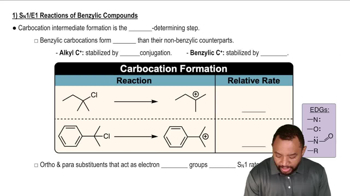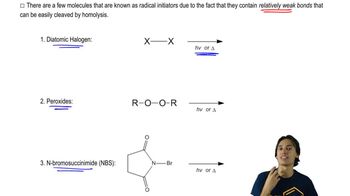Here are the essential concepts you must grasp in order to answer the question correctly.
Alkyl and Benzylic Radicals
Alkyl radicals are carbon-centered radicals that are formed by the homolytic cleavage of a carbon-hydrogen bond. Benzylic radicals, on the other hand, are a specific type of alkyl radical where the radical is located on a carbon adjacent to a benzene ring. Benzylic radicals are generally more stable than simple alkyl radicals due to resonance stabilization, which allows the unpaired electron to be delocalized over the aromatic system.
Recommended video:
Reactions at Benzylic Positions Concept 2
Free Radical Addition Mechanism
The free radical addition mechanism involves the addition of a radical species to a double bond, resulting in the formation of a new radical. In the case of 1-phenylpropene reacting with HBr in the presence of a radical initiator, the initiator generates bromine radicals that add to the double bond. This process leads to the formation of a more stable radical, which can then react with another bromine molecule to form the final product.
Recommended video:
The mechanism of Radical Polymerization.
Regioselectivity in Radical Reactions
Regioselectivity refers to the preference of a chemical reaction to yield one structural isomer over others. In the context of the addition of HBr to 1-phenylpropene, the stability of the resulting radical will influence the regioselectivity of the reaction. The more stable benzylic radical formed from the addition of the bromine radical to the double bond will be favored, leading to a specific product distribution based on the stability of the intermediates.
Recommended video:
What are Radical Initiators?
 Verified step by step guidance
Verified step by step guidance Verified video answer for a similar problem:
Verified video answer for a similar problem:



 6:14m
6:14m